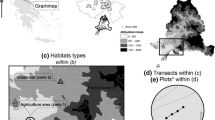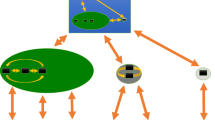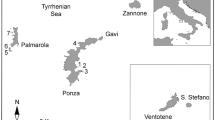Abstract
Islands host a subset of organisms occurring at their sources, and these assemblages are usually dominated by the most generalistic and dispersive species. In this study, we aim to identify which species are missing on islands and which ecological traits are responsible for differential occurrence. Then, we apply this information to beta diversity analyses. As a study group and area, we selected the Odonata in the Western Mediterranean. Based on the presence/absence of 109 species, we applied a series of analyses at both community and individual species level. The islands of the Balearics, Corsica, Sardinia and Malta are highly impoverished, but Sicily is not. Non-parametric multivariate adaptive regression splines predicted the occurrence of individual species on each island. Principal component analysis recognised differences between damselflies (Zygoptera) and dragonflies (Anisoptera), but members of the two suborders have similar occurrences on islands, and island occurrence is determined mostly by species’ frequencies at source and by their degree of generalism. Island species predicted correctly to occur on islands showed opposite characteristics to species unpredicted to occur and being present. The similarity pattern highlighted by turnover (Simpson index) is clearer than that obtained by non-partitioned beta diversity (Sørensen index). In fact, indicator value analyses revealed more indicator species for the Simpson compared to Sørensen index, and indicator species from islands where unpredicted to occur by impoverishment analysis. This suggests that island species predicted absent determine most of an island’s turnover pattern, thus encompassing fundamental biogeographic information. Due to their absence on nearest sources, they are also at higher risk of extinction, and deserving of special conservation effort.





Similar content being viewed by others
References
Baselga, A. (2010). Partitioning the turnover and nestedness components of beta diversity. Global Ecology and Biogeography, 19, 134–143.
Baselga, A. (2012). The relationship between species replacement, dissimilarity derived from nestedness, and nestedness. Global Ecology and Biogeography, 21, 1223–1232.
Boudot, J.-P., Kalkman, V. J., Azpilicueta Amorin, M., Bogdanovic, T., Cordero Rivera, A., Degabriele, G., et al. (2009). Atlas of the Odonata of the Mediterranean and North Africa. Libellula Supplement, 9, 1–256.
Carvalho, J. C., Cardoso, P., & Gomes, P. (2012). Determining the relative roles of species replacement and species richness differences in generating beta-diversity patterns. Global Ecology and Biogeography, 21, 760–771.
Cesaroni, D., Lucarelli, M., Allori, P., Russo, F., & Sbordoni, V. (1994). Patterns of evolution and multidimensional systematics in graylings (Lepidoptera: Hipparchia). Biological Journal of the Linnean Society, 52, 101–119.
Corbet, P. S. (2004). Dragonflies: Behaviour and ecology of Odonata. Colchester: Harley.
Dapporto, L. (2011). Predicting distribution of Zygaena moths on West Mediterranean islands. Implications for biogeography and conservation (Lepidoptera Zygaenidae). Journal of Insect Conservation, 15, 445–454.
Dapporto, L., & Bruschini, C. (2012). Invading a refugium: post glacial replacement of the ancestral lineage of a Nymphalid butterfly in the West Mediterranean. Organism Diversity and Evolution, 12, 39–49.
Dapporto, L., & Dennis, R. L. H. (2009). Conservation biogeography of large Mediterranean islands. Butterfly impoverishment, conservation priorities and inferences for an ecological “island paradigm”. Ecography, 32, 169–179.
Dapporto, L., Dennis, R.L.H. (2010). Skipper impoverishment on large West Mediterranean islands: deterministic, historical and stochastic factors. Biodiversity and Conservation, 19: 2637–2649
Dapporto, L., Schmitt, T., Vila, R., Scalercio, S., Biermann, H., Dincă, V., et al. (2011). Phylogenetic island disequilibrium: evidence for ongoing long-term population dynamics in two Mediterranean butterflies. Journal of Biogeography, 38, 854–867.
Dapporto, L., Bruschini, C., Dincă, V., Vila, R., & Dennis, R. L. H. (2012). Identifying zones of phenetic compression in West Mediterranean butterflies (Satyrinae): refugia, invasion and hybridization. Diversity and Distributions, 18, 1066–1076.
Dapporto, L., Ramazzotti, M., Fattorini, S., Talavera, G., Vila, R., & Dennis, R. L. H. (2013). Recluster: an unbiased clustering procedure for beta-diversity turnover. Ecography, 36, 1070–1075.
Dennis, R. L. H., & Shreeve, T. G. (1996). Butterflies on British and Irish offshore islands: Ecology and biogeography. Oxford: Gem.
Dennis, R. L. H., Williams, W. R., & Shreeve, T. G. (1991). A multivariate approach to the determination of faunal structures among European butterfly species (Lepidoptera: Rhopalocera). Zoological Journal of the Linnean Society, 101, 1–49.
Dennis, R. L. H., Shreeve, T. G., Olivier, A., & Coutsis, J. G. (2000). Contemporary geography dominates butterfly diversity gradients within the Aegean archipelago (Lepidoptera: Papilionoidea, Hesperioidea). Journal of Biogeography, 27, 1365–1383.
Dennis, R. L. H., Hardy, P. B., & Dapporto, L. (2012). Nestedness in island faunas: novel insights into island biogeography through butterfly community profiles of colonization ability and migration capacity. Journal of Biogeography, 39, 1412–1426.
Diamond, J. M. (1975). Assembly of species communities. In M. L. Cody & J. M. Diamond (Eds.), Ecology and evolution of communities (pp. 342–444). Cambridge: Belknap.
Dijkstra, K. D. B., & Lewington, R. (2006). Field guide to the dragonflies of Britain and Europe. Milton on Stour: British Wildlife Publishing.
Dincă, V., Dapporto, L., & Vila, R. (2011). A combined genetic-morphometric analysis unravels the complex biogeographical history of Polyommatus icarus and Polyommatus celina Common Blue butterflies. Molecular Ecology, 20, 3921–3935.
Dufrêne, M., & Legendre, P. (1997). Species assemblages and indicator species definition: the need of an asymmetrical and flexible approach. Ecological Monographs, 67, 345–366.
Elith, J., & Leathwick, J. (2007). Predicting species distribution from museum and herbarium records using multiresponse models fitted with multivariate adaptive regression splines. Diversity and Distributions, 13, 265–275.
Emerson, B. C. (2002). Evolution on oceanic islands: molecular phylogenetic approaches to understanding pattern and process. Molecular Ecology, 11, 951–966.
Emerson, B. C., & Gillespie, R. G. (2008). Phylogenetic analysis of community assembly and structure over space and time. Trends in Ecology and Evolution, 23, 619–630.
Emerson, B. C., Oromí, P., & Hewitt, G. M. (1999). MtDNA phylogeography and recent intra-island diversification of Canary Island Calathus beetles (Carabidae). Molecular Phylogenetics and Evolution, 13, 149–158.
Emerson, B. C., Oromí, P., & Hewitt, G. M. (2000a). Colonisation and diversification of the species Brachyderes rugatus (Coleoptera) on the Canary Islands: evidence from mtDNA COII gene sequences. Evolution, 54, 911–923.
Emerson, B. C., Oromí, P., & Hewitt, G. M. (2000b). Tracking colonisation and diversification of insect lineages on islands: MtDNA phylogeography of Tarphius canariensis (Coleoptera: Colydiidae) on the Canary Islands. Proceedings of the Royal Society of London B, 267, 2199–2205.
Fattorini, S. (2002). Biogeography of the tenebrionid bettles (Coleoptera, Tenebrionidae) on the Aegean Islands (Greece). Journal of Biogeography, 29, 49–67.
Fattorini, S. (2009), Both Recent and Pleistocene geography determine animaldistributional patterns in the Tuscan Archipelago. Journal of Zoology, 277: 291–301.
Fattorini, S., & Ulrich, W. (2012). Spatial distributions of European Tenebrionidae point to multiple postglacial colonization trajectories. Biological Journal of the Linnean Society, 105, 318–329.
Fattorini, S., Sciotti, A., Tratzi, P., & Di Giulio, A. (2013). Species distribution, ecology, abundance, body size and phylogeny originate interrelated rarity patterns at regional scale. Journal of Zoological Systematics and Evolutionary Research. doi:10.1111/jzs.12026.
Franck, P., Garnery, L., Celebrano, G., Solignac, M., & Cornuet, J. M. (2000). Hybrid origins of honeybees from Italy (Apis mellifera ligustica) and Sicily (A. m. sicula). Molecular Ecology, 9, 907–921.
Friedman, J. H. (1991). Multivariate adaptive regression splines. Annals of Statistics, 19, 1–141.
Giovannotti, M., Cerioni, P. N., Kalboussi, M., Aprea, G., & Caputo, V. (2007). Phylogeographic inferences from the mtDNAvariation of the three-toed skink, Chalcides chalcides (Reptilia: Scincidae). Journal of Experimental Zoology (Molecular and Developmental Evolution), 308B, 297–307.
Habel, J. C., Lens, L., Rödder, D., & Schmitt, T. (2011). From Africa to Europe and back: refugia and range shifts cause high genetic differentiation in the Marbled White butterfly Melanargia galathea. BMC Evolutionary Biology, 11, 215.
Hawkins, B. A. (2010). Multiregional comparison of the ecological and phylogenetic structure of butterfly species richness gradients. Journal of Biogeography, 37, 647–656.
Heiser, M., & Schmitt, T. (2010). Do different dispersal capacities influence the biogeography of the western Palearctic dragonflies (Odonata)? Biological Journal of the Linnean Society, 99, 177–195.
Hewitt, G. M. (1999). Post-glacial re-colonization of European biota. Biological Journal of the Linnean Society, 68, 87–112.
Hill, M. O., & Smith, A. J. E. (1976). Principal component analysis of taxonomic data with multi-state discrete characters. Taxon, 25, 249–255.
Husemann, M., Schmitt, T., Zachos, F. E., Ulrich, W., & Habel, J. C. (2013). Palaearctic biogeography revisited: evidence for the existence of a North African refugium for Western Palaearctic biota. Journal of Biogeography. doi:10.1111/jbi.12180.
Illies, J. (1976). Limnofauna Europaea. Jena: Fischer.
Koleff, P., Gaston, K. J., & Lennon, J. J. (2003). Measuring beta diversity for presence-absence data. Journal of Animal Ecology, 72, 367–382.
Kreft, H. & Jetz, W. (2010). A framework for delineating biogeographical regions based on species distributions. Journal of Biogeography, 37: 2029–2053.
Kudrna, O., Harpke, A., Lux, K., Pennerstorfer, J., Schweiger, O., Settele, J., et al. (2011). Distribution atlas of butterflies in Europe. Halle: Gesellschaft für Schmetterlingsschutz.
Leprieur, F., Olden, J. D., Lek, S., & Brosse, S. (2009). Contrasting patterns and mechanisms of spatial turnover for native and exotic freshwater fish in Europe. Journal of Biogeography, 36, 1899–1912.
Lomolino, M. V., Brown, J. H., & Sax, D. F. (2010). Island biogeography theory: Reticulations and reintegration of a biogeography of the species. In J. B. Losos & R. E. Ricklefs (Eds.), The theory of island biogeography revisited (pp. 13–51). Princeton: Princeton University Press.
Losos, J. B., & Ricklefs, R. E. (2010). The theory of island biogeography revisited. Princeton: Princeton University Press.
MacArthur, R. H., & Wilson, E. O. (1967). The theory of island biogeography. Princeton: Princeton University Press.
Masini, F., Petruso, D., Bonfigliom, L., & Mangano, G. (2008). Origination and extinction patterns of mammals in three central Western Mediterranean islands from the Late Miocene to Quaternary. Quaternary International, 182, 63–79.
Médail, F., & Diadema, K. (2009). Glacial refugia influence plant diversity patterns in the Mediterranean Basin. Journal of Biogeography, 36, 1333–1345.
Rosenzweig, M.L. (1995). Species Diversity in Space and Time. Cambridge: Cambridge University Press.
Santos, A. M. C., Quicke, D. L. J., Borges, P. A. V. & Hortal, J. (2011). Species pool structure determines the level of generalism of island parasitoid faunas. Journal of Biogeography, 38: 1657–1667.
Sara, M., & Vogel, P. (1996). Geographic variation of the Greater white-toothed shrew (Crocidura russula Hermann, 1780 Mammalia, Soricidae). Zoological Journal of the Linnean Society, 116, 377–392.
Schmitt, T. (2007). Molecular biogeography of Europe: Pleistocene cycles and postglacial trends. Frontiers in Zoology, 4, 11.
Simpson, G. G. (1943). Mammals and the nature of continents. American Journal of Science, 241, 1–31.
Stöck, M., Sicilia, A., Belfiore, N. M., Buckley, D., Lo Brutto, S., Lo Valvo, M., et al. (2008). Post-Messinian evolutionary relationships across the Sicilian channel: mitochondrial and nuclear markers link a new green toad from Sicily to African relatives. BMC Evolutionary Biology, 8, 56–74.
Tennent, J. (1996). The butterflies of Marocco, Algeria and Tunesia. Oxford: Gem.
Varga, Z., & Schmitt, T. (2008). Types of oreal and oreotundral disjunction in the western Palaearctic. Biological Journal of the Linnean Society, 93, 415–430.
Whittaker, R. J., & Fernández-Palacios, J. M. (2007). Island biogeography. Ecology, evolution and conservation. Oxford: Oxford University Press.
Wiemers, M. (1995). The butterflies of the Canary Islands—a survey on their distribution, biology and ecology (Lepidoptera: Papilionoidea and Hesperioidea). Linneana Belgica, 15, 63–84 and 87–118.
Williamson, M. (1981). Island populations. Oxford: Oxford University Press.
Acknowledgement
We thank the Deutsche Forschungs Gemeinschaft for a scholarship (M.H.) in the graduate school “Verbesserung von Normsetzung und Normanwendung im integrierten Umweltschutz durch rechts- und naturwissenschaftliche Kooperation”.
Author information
Authors and Affiliations
Corresponding author
Electronic supplementary material
Below is the link to the electronic supplementary material.
Appendix S1
(XLS 101 kb)
Appendix S2
(PDF 57 kb)
Rights and permissions
About this article
Cite this article
Heiser, M., Dapporto, L. & Schmitt, T. Coupling impoverishment analysis and partitioning of beta diversity allows a comprehensive description of Odonata biogeography in the Western Mediterranean. Org Divers Evol 14, 203–214 (2014). https://doi.org/10.1007/s13127-013-0161-3
Received:
Accepted:
Published:
Issue Date:
DOI: https://doi.org/10.1007/s13127-013-0161-3




